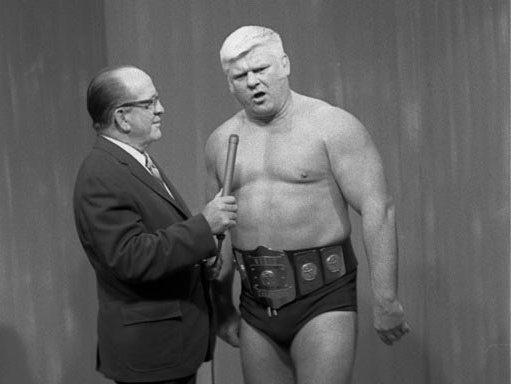Reggie Lisowski grew up in South Milwaukee and was raised in a prototypical Polish family on the South Side. He played football in high school, excelling as a fullback.
His football days were interrupted by World War II. Lisowski was stationed in Germany with the U.S. Army and it was there that he started dabbling in wrestling.
When he was discharged, he began working out at the Eagles Club and made his debut in 1949 against Marcel Buchet.
In the early years, The Crusher wrestled several times a week around Chicago while working as a bricklayer during the day to make ends meet. He joined Vern Gagne's AWA circuit in 1963 and went on to win three World Championships during his career and five Tag Team Championships, several of those with longtime partner Dick the Bruiser.
When the AWA started to wane in popularity, thanks to the rise of Hogan and McMahon's WWF, the Crusher joined the circuit on a part-time basis, working a number of smaller shows throughout the Midwest. He continued wrestling until retiring in 1988.
A natural in front of the camera, he recorded hundreds of interviews. His raspy, tough-man voice intimidating his opponents as he wielded a cigar was a perfect fit for his in-the-ring personality. In addition to warning his foes of impending doom, he always managed to work in a reference to Milwaukee as well as all the "dolls" that loved him.
Crusher was inducted into the WCW Hall of Fame in 1994 and occasionally worked on WWF pay-per-view shows, including a well-known 1998 event in Milwaukee, where he got into a ringside scuffle with Maurice "Mad Dog" Vachon and Jerry "The King Lawler."
Longtime WWE manager "Mouth of the South" Jimmy Hart was working with Lawler early in their careers when they faced The Crusher in Milwaukee. Back then, Hart and Lawler were wrestling in the Memphis area. Wrestling had not become the nationally-televised spectacle it is today.
At the same time, the pyrotechnic and thumping music entrances used by modern wrestlers were years in the future. Instead, a single ring announcer introduced the combatants. Hart was amazed by the response The Crusher received.
"He was introduced as ‘The Man that Made Milwaukee Famous,'" Hart says. "And The Bruiser was ‘The Most Dangerous Wrestler.' I just thought that was so wonderful.
"They were legends. I read about them in magazines growing up. I was so thrilled to be involved in that match."
He recalls the professionalism displayed by The Crusher and The Bruiser in their match.
"In the dressing room, he told us that he wasn't going to get to the manager until the end of the match. A lot of people wanted to pop the manager right off the bat for a quick spark."
Like his modern-day counterpart "Stone Cold" Steve Austin, The Crusher gained fame and won crowds over with his beer-drinking, strong man demeanor that played into blue-collar, tough-guy image that came to define postwar Milwaukee.
And that image helped make him a hero to the factory workers, machinists and other industrial, middle-class people that made up the majority of the city's population -- and his fan base.
He was a huge celebrity in his hometown, often taking part in various telethons and other charity events. In 1985, he even served as a guest conductor with the Milwaukee Symphony Orchestra at a fundraising event. While many celebrities -- then and now -- made appearances for a fee, The Crusher always showed up with a check in hand.
"He really believed that it was the fans - the Milwaukee fans - that made all this happen," says his daughter, Sherri Brozoski. "He was a bricklayer. He was proud of that background and he helped create that image of beer, brats and bars.
"And there's nothing wrong with that image."
Brozoski and siblings enjoyed watching their father wrestle. Growing up, they were regulars at his local matches. When he came home, The Crusher gave way to Dad; he was just another man wanting to spend time with his family, like anybody else.
Though, it was a different story when it came to his daughters and their suitors.
"There weren't a lot of dates," says Dawn Lisowski. "And he was always standing in the doorway when we got home."
Lisowski's sons, Larry and David, wrestled at South Milwaukee High School. His opponents always wanted to beat "the Crusher's son," and he was a fixture at those matches, cheering his sons on from the stands.
His status as one of wrestling's all-time greats remains unchallenged, but it's his devotion to his family, his daughters say, is the Crusher's true legacy. Both daughters credit their mother, Faye, for keeping the family strong during their father's many long work trips.
Faye passed away in 2003 and The Crusher followed, two years later.
"He loved his family. Family was everything. He never missed a football game or a wrestling meet. He loved his grandkids. They were his world."



